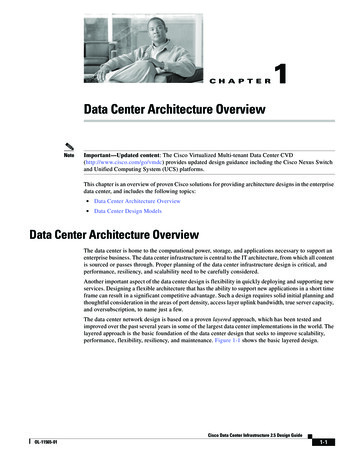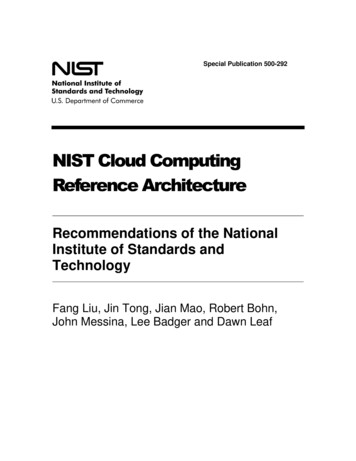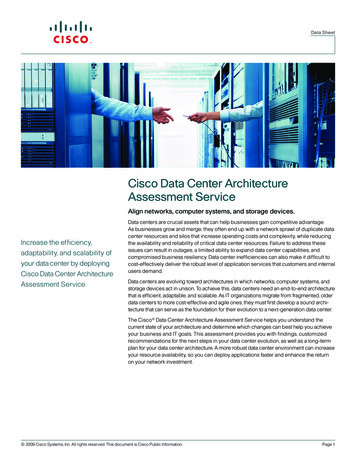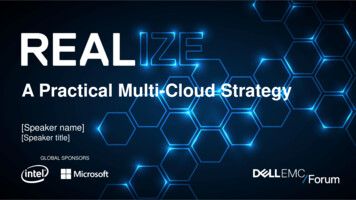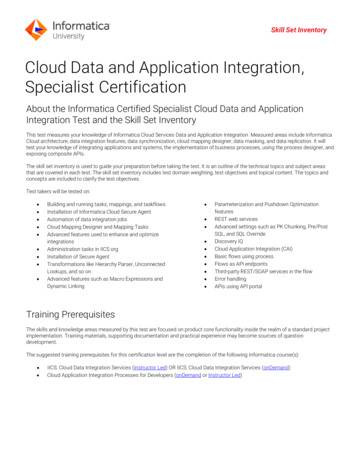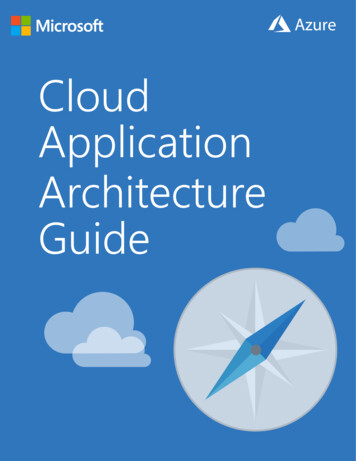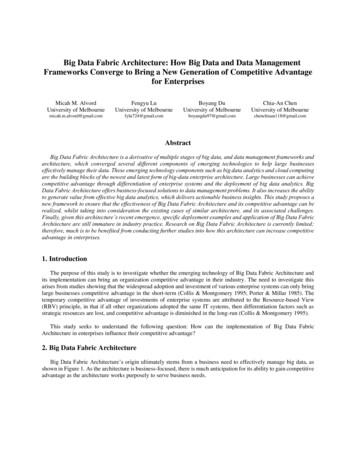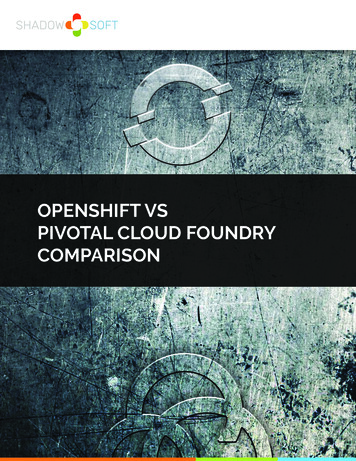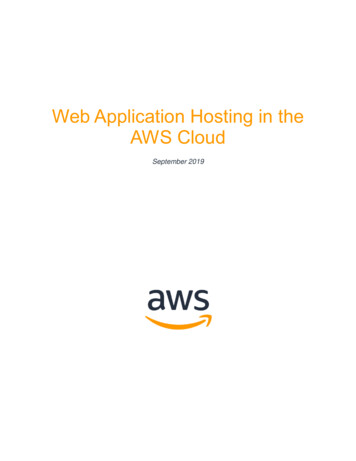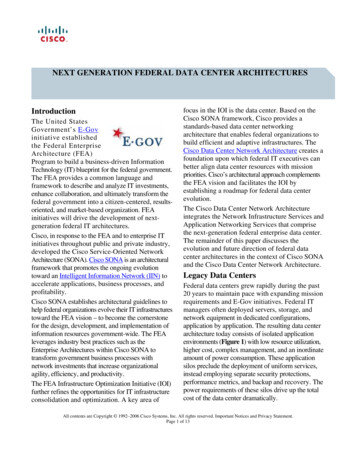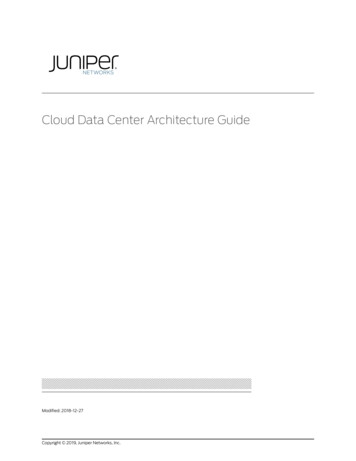
Transcription
Cloud Data Center Architecture GuideModified: 2018-12-27Copyright 2019, Juniper Networks, Inc.
Juniper Networks, Inc.1133 Innovation WaySunnyvale, California 94089USA408-745-2000www.juniper.netJuniper Networks, the Juniper Networks logo, Juniper, and Junos are registered trademarks of Juniper Networks, Inc. in the United Statesand other countries. All other trademarks, service marks, registered marks, or registered service marks are the property of their respectiveowners.Juniper Networks assumes no responsibility for any inaccuracies in this document. Juniper Networks reserves the right to change, modify,transfer, or otherwise revise this publication without notice.Cloud Data Center Architecture GuideCopyright 2019 Juniper Networks, Inc. All rights reserved.The information in this document is current as of the date on the title page.YEAR 2000 NOTICEJuniper Networks hardware and software products are Year 2000 compliant. Junos OS has no known time-related limitations through theyear 2038. However, the NTP application is known to have some difficulty in the year 2036.END USER LICENSE AGREEMENTThe Juniper Networks product that is the subject of this technical documentation consists of (or is intended for use with) Juniper Networkssoftware. Use of such software is subject to the terms and conditions of the End User License Agreement (“EULA”) posted athttps://support.juniper.net/support/eula/. By downloading, installing or using such software, you agree to the terms and conditions ofthat EULA.iiCopyright 2019, Juniper Networks, Inc.
Table of ContentsChapter 1Cloud Data Center Blueprint Architecture—Overview . . . . . . . . . . . . . . . . . . . 7About This Architecture Guide . . . . . . . . . . . . . . . . . . . . . . . . . . . . . . . . . . . . . . . . . . 7Cloud Data Center Terminology . . . . . . . . . . . . . . . . . . . . . . . . . . . . . . . . . . . . . . . . . 7Terminology . . . . . . . . . . . . . . . . . . . . . . . . . . . . . . . . . . . . . . . . . . . . . . . . . . . . . 7Introducing the Cloud Data Center Blueprint Architecture . . . . . . . . . . . . . . . . . . . 10Cloud Data Center Blueprint Architecture Introduction . . . . . . . . . . . . . . . . . . 10Evolution of the Data Center Network . . . . . . . . . . . . . . . . . . . . . . . . . . . . 10The Next Act for Data Center Networks . . . . . . . . . . . . . . . . . . . . . . . . . . . 11Building Blocks . . . . . . . . . . . . . . . . . . . . . . . . . . . . . . . . . . . . . . . . . . . . . . . . . . 12Cloud Data Center Blueprint Architecture Components . . . . . . . . . . . . . . . . . . . . . 13IP Fabric Underlay Network . . . . . . . . . . . . . . . . . . . . . . . . . . . . . . . . . . . . . . . . 14IPv4 and IPv6 Support . . . . . . . . . . . . . . . . . . . . . . . . . . . . . . . . . . . . . . . . . . . . 15Network Virtualization Overlays . . . . . . . . . . . . . . . . . . . . . . . . . . . . . . . . . . . . 15IBGP for Overlays . . . . . . . . . . . . . . . . . . . . . . . . . . . . . . . . . . . . . . . . . . . . 16Bridged Overlay . . . . . . . . . . . . . . . . . . . . . . . . . . . . . . . . . . . . . . . . . . . . . . 17Centrally-Routed Bridging Overlay . . . . . . . . . . . . . . . . . . . . . . . . . . . . . . 18Edge-Routed Bridging Overlay . . . . . . . . . . . . . . . . . . . . . . . . . . . . . . . . . 20Routed Overlay using EVPN Type 5 Routes . . . . . . . . . . . . . . . . . . . . . . . . 21Multihoming Support for Ethernet-Connected End Systems . . . . . . . . . . . . . 22Multihoming Support for IP-Connected End Systems . . . . . . . . . . . . . . . . . . . 23Data Center Interconnect (DCI) . . . . . . . . . . . . . . . . . . . . . . . . . . . . . . . . . . . . 24DHCP Relay . . . . . . . . . . . . . . . . . . . . . . . . . . . . . . . . . . . . . . . . . . . . . . . . . . . . 25ARP Synchronization and Suppression (Proxy ARP) . . . . . . . . . . . . . . . . . . . 26Chapter 2Cloud Data Center Reference Design—Tested Implementation . . . . . . . . . . 27Cloud Data Center Reference Design Overview and Validated Topology . . . . . . . . 27Reference Design Overview . . . . . . . . . . . . . . . . . . . . . . . . . . . . . . . . . . . . . . . 27Hardware and Software Summary . . . . . . . . . . . . . . . . . . . . . . . . . . . . . . . . . 29Interfaces Summary . . . . . . . . . . . . . . . . . . . . . . . . . . . . . . . . . . . . . . . . . . . . . 29Interfaces Overview . . . . . . . . . . . . . . . . . . . . . . . . . . . . . . . . . . . . . . . . . . 30Spine Device Interface Summary . . . . . . . . . . . . . . . . . . . . . . . . . . . . . . . 30Leaf Device Interface Summary . . . . . . . . . . . . . . . . . . . . . . . . . . . . . . . . 30IP Fabric Underlay Network Design and Implementation . . . . . . . . . . . . . . . . . . . . 31Configuring the Aggregated Ethernet Interfaces Connecting Spine Devicesto Leaf Devices . . . . . . . . . . . . . . . . . . . . . . . . . . . . . . . . . . . . . . . . . . . . . . 33Configuring an IP Address for an Individual Link . . . . . . . . . . . . . . . . . . . . . . . 38Enabling EBGP as the Routing Protocol in the Underlay Network . . . . . . . . . 39Enabling Load Balancing . . . . . . . . . . . . . . . . . . . . . . . . . . . . . . . . . . . . . . . . . . 41Configuring Micro Bidirectional Forwarding Detection on Member Links inAggregated Ethernet Interfaces . . . . . . . . . . . . . . . . . . . . . . . . . . . . . . . . 43Copyright 2019, Juniper Networks, Inc.iii
Cloud Data Center Architecture GuideIP Fabric Underlay Network — Release History . . . . . . . . . . . . . . . . . . . . . . . . 44Configuring IBGP for the Overlay . . . . . . . . . . . . . . . . . . . . . . . . . . . . . . . . . . . . . . . 46Bridged Overlay Design and Implementation . . . . . . . . . . . . . . . . . . . . . . . . . . . . . 52Configuring a Bridged Overlay . . . . . . . . . . . . . . . . . . . . . . . . . . . . . . . . . . . . . 53Configuring a Bridged Overlay on the Spine Device . . . . . . . . . . . . . . . . . 55Verifying a Bridged Overlay on the Spine Device . . . . . . . . . . . . . . . . . . . 55Configuring a Bridged Overlay on the Leaf Device . . . . . . . . . . . . . . . . . . 57Verifying the Bridged Overlay on the Leaf Device . . . . . . . . . . . . . . . . . . 60Bridged Overlay — Release History . . . . . . . . . . . . . . . . . . . . . . . . . . . . . . . . . 68Centrally-Routed Bridging Overlay Design and Implementation . . . . . . . . . . . . . . 68Configuring a VLAN-Aware Centrally-Routed Bridging Overlay in the DefaultInstance . . . . . . . . . . . . . . . . . . . . . . . . . . . . . . . . . . . . . . . . . . . . . . . . . . . 69Configuring a VLAN-Aware Centrally-Routed Bridging Overlay in theDefault Instance on the Spine Device . . . . . . . . . . . . . . . . . . . . . . . . 72Verifying the VLAN-Aware Centrally-Routed Bridging Overlay in theDefault Instance for the Spine Device . . . . . . . . . . . . . . . . . . . . . . . . 75Configuring a VLAN-Aware Centrally-Routed Bridging Overlay in theDefault Instance on the Leaf Device . . . . . . . . . . . . . . . . . . . . . . . . . 80Verifying the VLAN-Aware Centrally-Routed Bridging Overlay in theDefault Instance for the Leaf Device . . . . . . . . . . . . . . . . . . . . . . . . . 83Configuring a VLAN-Aware Centrally-Routed Bridging Overlay with VirtualSwitches . . . . . . . . . . . . . . . . . . . . . . . . . . . . . . . . . . . . . . . . . . . . . . . . . . 94Configuring the VLAN-Aware Centrally-Routed Bridging Overlay withVirtual Switches on a Spine Device . . . . . . . . . . . . . . . . . . . . . . . . . . 96Verifying the VLAN-Aware Model for a Centrally-Routed Bridging Overlaywith Virtual Switches on a Spine Device . . . . . . . . . . . . . . . . . . . . . . 98Configuring the VLAN-Aware Centrally-Routed Bridging Overlay withVirtual Switches on a Leaf Device . . . . . . . . . . . . . . . . . . . . . . . . . . 102Verifying the VLAN-Aware Centrally-Routed Bridging Overlay withVirtual Switches on a Leaf Device . . . . . . . . . . . . . . . . . . . . . . . . . . 104Centrally-Routed Bridging Overlay — Release History . . . . . . . . . . . . . . . . . . 107Multihoming an Ethernet-Connected End System Design andImplementation . . . . . . . . . . . . . . . . . . . . . . . . . . . . . . . . . . . . . . . . . . . . . . . . 107Configuring a Multihomed Ethernet-Connected End System using EVPNMultihoming with VLAN Trunking . . . . . . . . . . . . . . . . . . . . . . . . . . . . . . 109Enabling Storm Control . . . . . . . . . . . . . . . . . . . . . . . . . . . . . . . . . . . . . . . . . . 112Multihoming a Ethernet-Connected End System—Release History . . . . . . . . 113Edge-Routed Bridging Overlay Design and Implementation . . . . . . . . . . . . . . . . . 114Configuring an Edge-Routed Bridging Overlay on a Spine Device . . . . . . . . . 116Verifying the Edge-Routed Bridging Overlay on a Spine Device . . . . . . . . . . . 117Configuring an Edge-Routed Bridging Overlay on a Leaf Device . . . . . . . . . . 120Verifying the Edge-Routed Bridging Overlay on a Leaf Device . . . . . . . . . . . . 123Enabling Proxy ARP and ARP Suppression for the Edge-Routed BridgingOverlay . . . . . . . . . . . . . . . . . . . . . . . . . . . . . . . . . . . . . . . . . . . . . . . . . . . 127Disabling Proxy ARP and ARP Suppression for the Edge-Routed BridgingOverlay . . . . . . . . . . . . . . . . . . . . . . . . . . . . . . . . . . . . . . . . . . . . . . . . . . . 129Edge-Routed Bridging Overlay — Release History . . . . . . . . . . . . . . . . . . . . . 130ivCopyright 2019, Juniper Networks, Inc.
Table of ContentsRouted Overlay Design and Implementation . . . . . . . . . . . . . . . . . . . . . . . . . . . . . 131Configuring the Routed Overlay on a Spine Device . . . . . . . . . . . . . . . . . . . . 132Verifying the Routed Overlay on a Spine Device . . . . . . . . . . . . . . . . . . . . . . . 133Configuring the Routed Overlay on a Leaf Device . . . . . . . . . . . . . . . . . . . . . 135Verifying the Routed Overlay on a Leaf Device . . . . . . . . . . . . . . . . . . . . . . . . 137Routed Overlay — Release History . . . . . . . . . . . . . . . . . . . . . . . . . . . . . . . . . 140Multihoming an IP-Connected End System Design and Implementation . . . . . . . 141Configuring the End System-Facing Interfaces on a Leaf Device . . . . . . . . . 142Configuring EBGP Between the Leaf Device and the IP-Connected EndSystem . . . . . . . . . . . . . . . . . . . . . . . . . . . . . . . . . . . . . . . . . . . . . . . . . . . 143Multihoming an IP-Connected End System—Release History . . . . . . . . . . . . 144Data Center Interconnect Design and Implementation . . . . . . . . . . . . . . . . . . . . 144Data Center Interconnect Using EVPN Type 5 Routes . . . . . . . . . . . . . . . . . . 144Configuring Backbone Device Interfaces . . . . . . . . . . . . . . . . . . . . . . . . . 147Enabling EBGP as the Underlay Network Routing Protocol Between theSpine Devices and the Backbone Devices . . . . . . . . . . . . . . . . . . . . 149Enabling IBGP for the Overlay Network on the Backbone Device . . . . . 152Enabling EBGP as the Routing Protocol Between the BackboneDevices . . . . . . . . . . . . . . . . . . . . . . . . . . . . . . . . . . . . . . . . . . . . . . . . 155Configuring the Routing Instances to Support DCI Using EVPN Type 5Routes . . . . . . . . . . . . . . . . . . . . . . . . . . . . . . . . . . . . . . . . . . . . . . . . 158Verifying That DCI Using EVPN Type 5 Routes is Operating . . . . . . . . . . 161Data Center Interconnect—Release History . . . . . . . . . . . . . . . . . . . . . . 165DHCP Relay Design and Implementation . . . . . . . . . . . . . . . . . . . . . . . . . . . . . . . 165Enabling DHCP Relay: DHCP Client and Server in Same VLAN and Connectedto Same Leaf Device . . . . . . . . . . . . . . . . . . . . . . . . . . . . . . . . . . . . . . . . 166Enabling DHCP Relay: DHCP Client and Server in Same VLAN and Connectedto Different Leaf Devices . . . . . . . . . . . . . . . . . . . . . . . . . . . . . . . . . . . . . 168Enabling DHCP Relay: DHCP Client and Server in Different VLANs . . . . . . . 168DHCP Relay — Release History . . . . . . . . . . . . . . . . . . . . . . . . . . . . . . . . . . . . 170Chapter 3Appendices . . . . . . . . . . . . . . . . . . . . . . . . . . . . . . . . . . . . . . . . . . . . . . . . . . . . . . 171Appendix: Cloud Data Center Reference Design Testing Summary . . . . . . . . . . . . 171Appendix: Cloud Data Center Reference Design Scaling Summary . . . . . . . . . . . 172Copyright 2019, Juniper Networks, Inc.v
Cloud Data Center Architecture GuideviCopyright 2019, Juniper Networks, Inc.
CHAPTER 1Cloud Data Center BlueprintArchitecture—Overview About This Architecture Guide on page 7 Cloud Data Center Terminology on page 7 Introducing the Cloud Data Center Blueprint Architecture on page 10 Cloud Data Center Blueprint Architecture Components on page 13About This Architecture GuideThe purpose of this guide is to provide networking professionals with the concepts andtools needed to build multiservice cloud data center networks.The intended audience for this guide includes system integrators, infrastructureprofessionals, partners, and customers that are currently using or considering upgradingto a high-end IP fabric cloud data center architecture.Cloud Data Center TerminologyThis section provides a summary of commonly used terms, protocols, and building blocktechnologies used in this blueprint architecture. Terminology on page 7 ARP—Address Resolution Protocol. A protocol defined in RFC 826 for mapping a logicalIP address to a physical MAC address. Backbone Device—A device in the WAN cloud that is directly connected to a spinedevice or devices in a data center. Backbone devices are required in this referencetopology to provide physical connectivity between data centers that are interconnectedusing a data center interconnect (DCI). Bridged Overlay—An Ethernet-based overlay service designed for data centerenvironments that do not require routing within an EVPN/VXLAN fabric. IP routing canprovided externally to the fabric as needed.TerminologyCopyright 2019, Juniper Networks, Inc.7
Cloud Data Center Architecture Guide8 BUM—Broadcast, Unknown Unicast, and Multicast. The BUM acronym collectivelyidentifies the three traffic types. Centrally-Routed Bridging Overlay—A form of IRB overlay that provides routing at acentral gateway and bridging at the edge of the overlay network. In an IRB overlay, arouted overlay and one or more bridged overlays connect at one or more locationsthrough the use of IRB interfaces. Clos Network—A multistage network topology first developed by Charles Clos fortelephone networks that provides multiple paths to a destination at each stage of thetopology. Non-blocking networks are possible in a Clos-based topology. DCI—Data Center Interconnect. The technology used to interconnect separate datacenters. Default instance—A global instance in a Juniper Networks device that hosts the primaryrouting table such as inet.0 (default routing instance) and the primary MAC addresstable (default switching instance). DHCP relay—A function that allows a DHCP server and client to exchange DHCPmessages over the network when they are not in the same Ethernet broadcast domain.DHCP relay is typically implemented at a default gateway. EBGP—External BGP. A routing protocol used to exchange routing information betweenautonomous networks. It has also been used more recently in place of a traditionalInterior Gateway Protocols, such as IS-IS and OSPF, for routing within an IP fabric. Edge-Routed Bridging Overlay—A form of IRB overlay that provides routing and bridgingat the edge of the overlay network. End System—An endpoint device or devices that connects into the data center. Anend system can be a wide range of equipment but is often a server, a router, or anothernetworking device in the data center. ESI—Ethernet segment identifier. An ESI is a 10-octet integer that identifies a uniqueEthernet segment in EVPN. In this blueprint architecture, LAGs with member links ondifferent access devices are assigned a unique ESI to enable Ethernet multihoming. Ethernet-connected Multihoming—An Ethernet-connected end system that connectsto the network using Ethernet access interfaces on two or more devices. EVPN—Ethernet Virtual Private Network. A VPN technology that supports bridged,routed, and hybrid network overlay services. EVPN is defined in RFC 7432 with extensionsdefined in a number of IETF draft standards. EVPN Type 5 Routes—An EVPN Type 5 route is a route type that separates the hostMAC from it’s IP address to provide a clean IP prefix advertisement. EVPN Type 5 routesare exchanged between spine devices in different data centers in this referencearchitecture when EVPN Type 5 routes are used for Data Center Interconnect (DCI).EVPN Type 5 routes are also called IP Prefix routes. IBGP—Internal BGP. In this blueprint architecture, IBGP with Multiprotocol BGP(MP-IBGP) is used for EVPN signalling between the devices in the overlay. IP Fabric—An all-IP fabric network infrastructure that provides multiple symmetricpaths between all devices in the fabric.Copyright 2019, Juniper Networks, Inc.
Chapter 1: Cloud Data Center Blueprint Architecture—Overview IP-connected Multihoming—An IP-connected end system that connects to the networkusing IP access interfaces on two or more devices. IRB—Integrated Routing and Bridging. A technique that enables routing between VLANsand allows traffic to be routed or bridged based on whether the destination is outsideor inside of a bridging domain. To activate IRB, you associate a logical interface (IRBinterface) with a VLAN and configure the IRB interface with an IP address for the VLANsubnet. NDP—Neighbor Discovery Protocol. An IPv6 protocol defined in RFC 4861 that combinesthe functionality of ARP and ICMP, and adds other enhanced capabilities. Routed Overlay—An IP-based overlay service where no Ethernet bridging is required.Also referred to as an IP VPN. In this blueprint architecture, the routed overlay is basedon EVPN Type 5 routes and their associated procedures, and supported by VXLANtunneling. Leaf Device—An access level network device in an IP fabric topology. End systemsconnect to the leaf devices in this blueprint architecture. MicroBFD—Micro Bidirectional Forwarding Detection (BFD). A version of BFD thatprovides link protection on individual links in an aggregated Ethernet interface. Multiservice Cloud Data Center Network—A data center network that optimizes theuse of available compute, storage, and network access interfaces by allowing themto be shared flexibly across diverse applications, tenants, and use cases. Spine Device—A centrally-located device in an IP fabric topology that has a connectionto each leaf device. Storm Control—Feature that prevents BUM traffic storms by monitoring BUM trafficlevels and taking a specified action to limit BUM traffic forwarding when a specifiedtraffic level is exceeded. Underlay Network—A network that provides basic network connectivity betweendevices.In this blueprint architecture, the underlay network is an IP Fabric that providesbasic IP connectivity. VLAN trunking—The ability for one interface to support multiple VLANs. VNI—VXLAN Network Identifier. Uniquely identifies a VXLAN virtual network. A VNIencoded in a VXLAN header can support 16 million virtual networks. VTEP—VXLAN Tunnel Endpoint. A loopback or virtual interface where traffic entersand exits a VXLAN tunnel. Tenant traffic is encapsulated into VXLAN packets at asource VTEP, and de-encapsulated when the traffic leaves the VXLAN tunnel at aremote VTEP. VXLAN—Virtual Extensible LAN. Network virtualization tunneling protocol defined inRFC 7348 used to build virtual networks over an IP-routed infrastructure. VXLAN isused to tunnel tenant traffic over the IP fabric underlay from a source endpoint at aningress device to a destination endpoint at the egress device. These tunnels areestablished dynamically by EVPN. Each VTEP device advertises its loopback addressin the underlay network for VXLAN tunnel reachability between VTEP devices.Copyright 2019, Juniper Networks, Inc.9
Cloud Data Center Architecture GuideRelatedDocumentation Cloud Data Center Blueprint Architecture Components on page 13Introducing the Cloud Data Center Blueprint Architecture Cloud Data Center Blueprint Architecture Introduction on page 10 Building Blocks on page 12Cloud Data Center Blueprint Architecture IntroductionThis section provides an introduction to the Cloud Data Center Blueprint Architecture.It includes the following sections. Evolution of the Data Center Network on page 10 The Next Act for Data Center Networks on page 11Evolution of the Data Center NetworkFor certain problems, complexity is intractable. It can be shifted from one form to another,but cannot be eliminated. The issue of managing complexity has been true of networksof any notable scale and diversity of purpose, and the data center network has been noexception.In the 1990’s, the demands on the data center network were lower. Fewer large systemswith predetermined roles dominated. Security was lax and so networks were mostlyunsegmented. Storage was direct-attached. Large chassis-based network equipmentwas centrally placed. Constraints in data center power, space, and cooling necessitateda means to place a system in a location that optimized for these other resources, whileconnecting it to the network switch designated for that end system’s business function.Structured cabling became the ticket to getting the most out of the system.When storage became disaggregated, the IP network and protocol stack was not readyfor its demands, resulting in a parallel network for storage using Fibre Channel technology.This technology was built on the premise that the network must be lossless. The “besteffort” IP/Ethernet stack was not suitable. Structured cabling continued to dominate inthis era.As larger systems gave way to smaller systems, end-of-row network designs appeared.Small fixed form factor switches were not ready to take on enterprise data centerworkloads, so chassis-based switches continued to dominate. The need for bothsegmentation and freedom of end-system placement led to the three-tier multihoplearning bridge network designs using the brittle STP to eliminate loops. The multihoplearning bridge network allowed operators the flexibility to place an end system at anylocation within the physical span of the bridge network. This reduced the dependenceon structured cabling at the expense of network capacity and catastrophic networkmeltdowns, two issues related to the limitations of STP.In the last act, end systems became compact enough to fit 30 or more in a single rack,constrained mainly by power and cooling capacity. With this rack density, combined withthe emergence of data center grade 1RU switches, came the top-of-rack (ToR) design.10Copyright 2019, Juniper Networks, Inc.
Chapter 1: Cloud Data Center Blueprint Architecture—OverviewThe ToR switch replaced the passive patch panel, and the heyday of structured cablingcame to an end. Yet the brittle three-tier learning bridge network design remained. Thelack of control plane redundancy in ToR switches, the desire to leverage all availablelinks, and the inability of the learning bridge network and STP to scale to the significantincrease in network switches led to the addition of MC-LAG, which reduced the exposureof link failures to the STP, giving STP one last act.Finally, operating a second Fibre Channel network became too expensive as systemsdisaggregated. Attempts to force fit Fibre Channel onto Ethernet ensued for a while,resulting in Data Center Bridging (DCB), an attempt to make Ethernet perform losslessforwarding. During this time, a second act for Ethernet came in the form of TransparentInterconnection of Lots of Links (TRILL), an Ethernet-on-Ethernet overlay protocol thatuses IS-IS for route distribution, and its derivatives -- a misguided attempt to performhop-by-hop routing with Ethernet addresses that simply did not (and could not) go farenough. Both DCB and TRILL were evolutionary dead ends. In this chaos, both EVPN andSDN were born.For a variety of reasons, these past architectures and technologies were often limited toserving a specific use case. Multiple use cases often required multiple networks connectingdifferent end systems. This lack of agility in compute, storage, and network resourcesled to cloud technologies, like Kubernetes and EVPN. Here “cloud” is defined asinfrastructure that frees the operator to implement any use case on the same physicalinfrastructure, on demand, and without any physical changes.In the present generation of “cloud,” workloads present themselves to the network in theform of virtual machines or containers that are most often free to move between physicalcomputers. Storage is fully IP-based, and in many cases it is highly distributed. Theendpoint scale and dynamism in cloud is the straw that broke the back of the learningbridge network. Meanwhile, Fibre Channel is on its deathbed.The Next Act for Data Center NetworksFor truly cloud-native workloads that have no dependency on Ethernet broadcast,multicast, segmentation, multitenancy, or workload mobility, the best network solutionis typically a simple IP fabric network. In cases where a unique workload instance requiresmobility, the current host system can advertise the unique IP address of the workload.This can be performed with EBGP route exchange between the host system and the ToR.However, support for BUM and multitenancy require more advanced network functions.This is where overlays are added to the picture.One can observe that the nature of the data center network over its evolution was afunction of the demands and expectations placed on it. As the nature of workloadschanged, the network had to adapt. Each solution simplified a set of problems by tradingoff one form of complexity and cost for another. The cloud network is no different. In theend, bits must be moved from point A to point B reliably, securely, and at the desiredthroughput. Where operators need a single network to serve more than one purpose (themultiservice cloud network), they can add network-layer segmentation and certainadditional functions to share the infrastructure resources across diverse groups ofendpoints and tenants. Operational simplicity is achieved by way of a centralized controllerthat implements an intent model that is consistent with the cloud scale functions of theCopyright 2019, Juniper Networks, Inc.11
Cloud Data Center Architecture Guidenetwork layer. Technical simplicity is achieved using a reduced set of building blocks thatare based on open standards and homogeneous across the entire end-to-end network.This guide introduces a building block approach to creating multiservice cloud networkson the foundation of a modern IP fabric. The Juniper Networks solutions team willsystematically review the set of functional building blocks required for an agile network,focus on specific, state-of-the-art, open standards-based technology that enables eachfunction, and add new functionality to the guide as it becomes available in future softwarereleases. All the building blocks are fully synergistic and any of the functional buildingblock solutions can be combined with any other to satisfy a diverse set of use casessimultaneously — this is the hallmark of the cloud. You should consider how the set ofbuilding blocks presented in this guide can be leveraged to achieve the use cases thatare relevant to you and your network.Building BlocksThe guide organizes the technologies used to build multiservice cloud networkarchitectures into modular building blocks. Each building block includes one or morefeatures that either must be implemented together to build the network, are oftenimplemented together because they provide complementary functionality, or arepresented together to provide an analysis of the choices for particular technologies.This blueprint architecture includes required building blocks and optional building blocks.The optional building blocks can be added or removed to support the requirements of aspecific multiservice cloud data center network.This guide walks readers through the possible design and technology choices associatedwith each building block, and provides information designed to help you choose thebuilding blocks that best meet the requirements for your multiservice cloud data centernetwork. The guide also provides the implementation procedures for each functionalitywithin each building block.The currently-supported building blocks include: IP Fabric Underlay Network Network Virtualization Overlays 12 Centrally-Routed Bridging Overlay Edge-Routed Bridging Overlay Routed OverlayMultihoming Multihoming of Ethernet-connected End Systems Multihoming of IP-connected End Systems Data Center Interconnect (DCI) DHCP RelayCopyright 2019, Juniper Networks, Inc.
Chapter 1: Cloud Data Center Blueprint Architecture—OverviewAdditional building blocks will be added to this guide as support for the technologybecomes available and is validated by the Juniper Networks testing team.Planned building blocks include: Network Virtualization Overlays Optimized Overlay Replication Overlay Border Gateways Network Access Control Differentiated Services Timing Distribution Network HardeningEach individual building block is discussed in more detail in “Cloud Data Center BlueprintArchitecture Components” on page 13.RelatedDocumentation Cloud Data Center Reference Design Overview and Validated Topology on page 27 Cloud Data Center Blueprint Architecture Components on page 13Cloud Data Center Blueprint Architecture ComponentsThis section provides an overview of the building block technologies used in this blueprintarchitecture. The impl
Dec 27, 2018 · 5. Caddressforasubnet usingthegatewayIRBaddressonthecent
